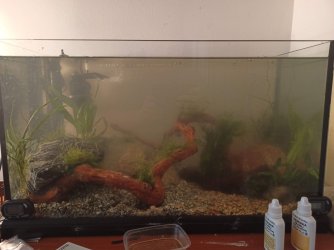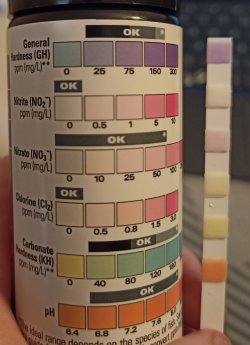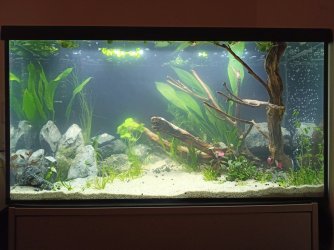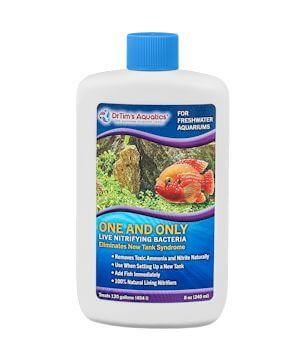Hi again everyone!
First of all thank you so much for all of your help and advice in my last thread. I am so grateful, especially since I don't know of any aquarium hobbyists or groups irl. For this thread I'd like to hear your opinions/advice for fishless cycling. Last year I first attempted to keep an aquarium, and it was a bit of a disaster. Had only gravel, drift wood and stones. Some java ferns and moss. Even though I had done a lot of research, there were a few things I missed. Java moss dissolved into the gravel and my PH wasn't right for guppies apparently (I had asked for help in a small petshop in a neighbouring town). I was trying to do a fish-in cycle and when the ammonia spiked I panicked and did way too much water changing and shocked the guppies. I actually lost all three of the guppies and I was so upset with myself. (Image of my old/first aquarium attached)
In the last few weeks I have set up my second attempt at keeping an aquarium. Through research and watching aquarium based content I have learned a lot over the last year and I'm taking the journey slow this time. Starting with a fishless cycle.
Tank:
Before I had set up my tank, I was thinking of using liquid ammonia to cycle the tank but I had read that fish food has other nutrients that are also important. Now I'm reconsidering, because the liquid ammonia seems far easier to control. Especially because I have to guess with the fish food. The issue is that liquid ammonia (specifically Dr. Tims) seems really difficult to find here in Ireland. I can't find anywhere cheaper than €30 on Ebay with shipping for a 2oz bottle. I'm a little reluctant to try and find ammonia in household cleaning supplies, which some say can be fine and others are horrified. Honestly, I really don't want to be waiting a long time for shipping and pay insane prices for Dr. Tims on Ebay. So I don't know how to proceed.
It's personally important to me to plan ahead quite far in advance, so I'm doing my best to research potential fish for after the tank is cycled. So far I am considering/researching a community tank with Ember tetras, or just tiger barbs. Maybe some other bottom feeders or something with the tiger barbs, though I know that tiger barbs are pretty notorious fin nippers. I do love angel fish but my tank is too small. I'm not set on those ideas, but since there are so many species of tropical fish I just chose to research the first pretty ones I found LOL
Below I'll attach pictures of my old aquarium, then of the water test strip and lastly my new tank! I'm quite proud of my tank, I think it looks good for a second attempt!
In conclusion, the topics I would really like feedback or advice on are:
1. Fishless cycling
2. Fish/tank inhabitants
I'd really appreciate any help you can offer, have a great day!
First of all thank you so much for all of your help and advice in my last thread. I am so grateful, especially since I don't know of any aquarium hobbyists or groups irl. For this thread I'd like to hear your opinions/advice for fishless cycling. Last year I first attempted to keep an aquarium, and it was a bit of a disaster. Had only gravel, drift wood and stones. Some java ferns and moss. Even though I had done a lot of research, there were a few things I missed. Java moss dissolved into the gravel and my PH wasn't right for guppies apparently (I had asked for help in a small petshop in a neighbouring town). I was trying to do a fish-in cycle and when the ammonia spiked I panicked and did way too much water changing and shocked the guppies. I actually lost all three of the guppies and I was so upset with myself. (Image of my old/first aquarium attached)
In the last few weeks I have set up my second attempt at keeping an aquarium. Through research and watching aquarium based content I have learned a lot over the last year and I'm taking the journey slow this time. Starting with a fishless cycle.
Tank:
- Aquael Leddy 75
- 105 L
- 75x35x40 cm
- Filter: Aquael ASAP 500
- Heater (with guard): Bonlux 100W
- Air pump: Zacro dual outlet (one airstone bar and one outlet split into two regular airstones)
- Lighting: Retrofit Day & Night
- Substrate: 5L lava gravel at the back, layer of Rotala Malflora Light Aquarium Soil and Ada La Plata sand.
- Hardscape: Seiryu stone and mangle wood
- Mix of aquarium plants
- GH of 75
- KH of 0 (or just very low) (see image on test strip)
- PH: 6.8
- Dechlorinated with Seachem Prime
Before I had set up my tank, I was thinking of using liquid ammonia to cycle the tank but I had read that fish food has other nutrients that are also important. Now I'm reconsidering, because the liquid ammonia seems far easier to control. Especially because I have to guess with the fish food. The issue is that liquid ammonia (specifically Dr. Tims) seems really difficult to find here in Ireland. I can't find anywhere cheaper than €30 on Ebay with shipping for a 2oz bottle. I'm a little reluctant to try and find ammonia in household cleaning supplies, which some say can be fine and others are horrified. Honestly, I really don't want to be waiting a long time for shipping and pay insane prices for Dr. Tims on Ebay. So I don't know how to proceed.
It's personally important to me to plan ahead quite far in advance, so I'm doing my best to research potential fish for after the tank is cycled. So far I am considering/researching a community tank with Ember tetras, or just tiger barbs. Maybe some other bottom feeders or something with the tiger barbs, though I know that tiger barbs are pretty notorious fin nippers. I do love angel fish but my tank is too small. I'm not set on those ideas, but since there are so many species of tropical fish I just chose to research the first pretty ones I found LOL
Below I'll attach pictures of my old aquarium, then of the water test strip and lastly my new tank! I'm quite proud of my tank, I think it looks good for a second attempt!
In conclusion, the topics I would really like feedback or advice on are:
1. Fishless cycling
2. Fish/tank inhabitants
I'd really appreciate any help you can offer, have a great day!






